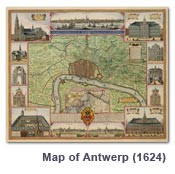Date/Time
Friday, March 1, 2013–Saturday, March 2, 2013
All Day
Location
William Andrews Clark Memorial Library
2520 Cimarron Street
—a conference organized by Peter Arnade, University of Hawai’i at Mānoa, and Margaret Jacob, University of California, Los Angeles

As Richard L. Kagan has argued, the Spanish employed the founding of cities as a tool of imperial legitimacy in ways other emerging colonial powers did not, creating an “empire of cities.” In Europe established urban centers from Brussels to Naples underwent political change and spatial redesign, often at the expense of older, republican commitments, while a new court capital, Madrid, was dramatically transformed. In the Americas Mexico City was reshaped out of the violent demise of Tenochtitlan, while Lima was founded as a new viceregal capital and strategic alternative to the old Inca capital of Cuzco.
There has been some recent attention to the general contour of early modern Spanish cities, but none to the comparative issue of the city in the Habsburg world. This conference proposes to do just that, casting the net wide from northern Europe to Italy and the Viceroyalties of Peru and New Spain. Apart from the framework of the Habsburg Empire itself, the common denominator of the interest is the political construction and alteration of urban public space: how old communal spaces were remade into Baroque showcases of monarchical power, and how, in overseas territories, urbanism was the cornerstone of monarchical legitimacy. The end point is the Baroque city of the seventeenth century and its transformed look, from grand public squares to royal citadels and new fortifications. The conference explores the political motives and economic implications of the momentous spatial redesign, with special attention to city fortifications, marketplaces, public squares, royal residences, religious architecture, and pentagonal citadels.
Program
Session 1: Urbanism in the Americas
Chair: Teofilo Ruiz, University of California, Los Angeles
Linda A. Curcio-Nagy, University of Nevada, Reno
“The Politics of Recreation: Ritual and the Alameda Central”
Alejandro Cañeque, University of Maryland, College Park
“Mexico City and the Martyrs of Japan: The Local and Imperial Identity of a New World Metropolis”
Michael Schreffler, Virginia Commonwealth University
“What Kind of Settlement Was Spanish Colonial Cuzco?”
Session 2: Habsburg Italian Cities
Chair: Anna More, University of California, Los Angeles
Stefano D’Amico, Texas Tech University
“The Governor, the Bishop, and the Merchant: The Cathedral Square and the Use of Urban Space in Spanish Milan”
John A. Marino, University of California, San Diego
“The Way of the Viceroy: Mapping Spanish Power in Baroque Naples”
Session 3: Imperial and Local Spaces
Chair: Charlene Villaseñor Black, University of California, Los Angeles
Alejandra B. Osorio, Wellesley College
“The City, the King, and Imperial Culture: Lima, Lisbon, Madrid, Naples, and Manila”
James S. Amelang, Autonomous University of Madrid
“The Walk of the Town: The Origins of Early Modern Urban Discourse”
Jesús Escobar, Northwestern University
“The Babylon of the Spanish Habsburg World: Madrid and Its Representation”
Session IV: The Habsburg North
Chair: Peter Arnade, University of Hawai’i at Mānoa
Luc Duerloo, University of Antwerp
“Courting the City: The Archdukes Albert and Isabella and Brussels”
Martha Pollak, University of Illinois, Chicago
“Antwerp’s Early Modern Military Assets and Political Ceremonies”
Concluding Remarks
Richard L. Kagan, Johns Hopkins University
“An Empire of Towns: Some New Perspectives”

